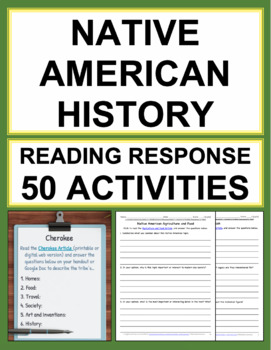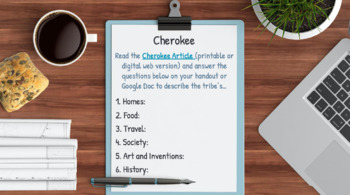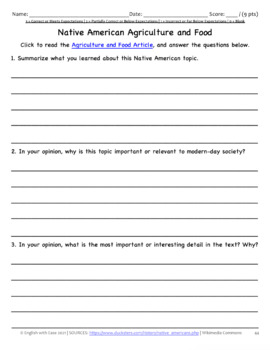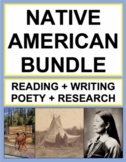Native American History and Heritage Month Reading and Writing Activities
- Zip
- Google Apps™

What educators are saying
Also included in
- Native American reading and writing activities (Printable & Digital) for Social Studies or ELA classroom activities, distance learning or Google Classroom activities for Indigenous People's Day (Columbus Day), Native American Heritage Month (November) or anytime of year during your Native AmericPrice $12.00Original Price $18.00Save $6.00
Description
Native American History reading and writing activities perfect for Native American Heritage Month (November) or Indigenous Peoples Day (Columbus Day) - 50 reading response and writing activities (Printable & Digital) about Native American historical figures, historical events, culture daily life and more - including student printables, lesson plan, PowerPoint slides, Google Doc, Google Slides, grading rubric and links to 41 nonfiction texts for Social Studies or ELA classroom activities, distance learning or Google Classroom activities.
Native American History and Heritage activities are designed to be appropriate for all ages as you can read the texts aloud to younger students or allow older students to read independently. The editable product also includes elementary and secondary writing prompts (expository, persuasive, narrative).
The reading response and writing activities listed below can be paired with ANY Native American History topic, event or leader and are aligned with social studies and ELA standards. Articles and activities can be completed independently with older students or strong readers or as a whole-class activity with younger students.
Depending on your classroom needs, pick and choose from 8 reading response and writing activities to pair with each of the 40 informational texts.
Product Includes (Printable & Digital):
- Lesson Plan
- Student Printables
- PowerPoint Slides
- Google Doc
- Google Slides
- KWL Chart Bell Ringer & Exit Slip
- Grading Rubric
- Table of Contents
- ELA Reading Response Handout
- ELA Informative/Explanatory/Expository Writing Prompt
- ELA Opinion Writing Prompt
- ELA Research Writing Prompt
- ELA Narrative/Creative Writing Prompt
- Social Studies Informative/Explanatory/Expository Writing Prompt
- Social Studies Research Writing Prompt
- Social Studies Opinion Writing Prompt
10 Native American Leaders - Reading Response Handouts and Text Links:
- Tecumseh
- Crazy Horse
- Geronimo
- Chief Joseph
- Sacagawea
- Sitting Bull
- Sequoyah
- Squanto
- Maria Tallchief
- Jim Thorpe
14 Native American Tribes - Reading Response Handouts and Text Links:
- Apache
- Blackfoot
- Cherokee
- Cheyenne
- Chickasaw
- Cree
- Inuit
- Iroquois
- Navajo
- Nez Perce
- Osage
- Pueblo
- Seminole
- Sioux
5 Native American Historical Events - Reading Response Handouts and Text Links:
- King Phillips War
- French and Indian War
- Battle of Little Bighorn
- Trail of Tears
- Wounded Knee Massacre
12 Native American Topics - Reading Response Handouts and Text Links:
- Indian Reservations
- Civil Rights
- Agriculture and Food
- Art
- Homes and Dwellings
- Clothing
- Entertainment
- Gender Roles
- Social Structures
- Life as a Child
- Religion
- Mythology and Legends
SEE PREVIEW
This product is aligned with ELA Common Core and Social Studies History Content Standards for the State of California, which are also aligned with the official socialstudies.org standards and the Department of Defense Education Standards:
- California State Standards for Social Studies
- Department of Defense (dodea) Standards for Social Studies
- Socialstudies.org Standards for Social Studies
- K.6 Students understand that history relates to events, people, and places of other times.
- 2.5 Students understand the importance of individual action and character and explain how heroes from long ago and the recent past have made a difference in others’ lives.
- 1.5.2. Understand the ways in which American Indians and immigrants have helped define Californian and American culture.
- 1.5.3. Compare the beliefs, customs, ceremonies, traditions, and social practices of the varied cultures, drawing from folklore.
- 3.2. Students describe the American Indian nations in their local region long ago and in the recent past.
- 1. Describe national identities, religious beliefs, customs, and various folklore traditions.
- 2. Discuss the ways in which physical geography, including climate, influenced how the local Indian nations adapted to their natural environment (e.g., how they obtained food, clothing, tools).
- 3. Describe the economy and systems of government, particularly those with tribal constitutions, and their relationship to federal and state governments.
- 4. Discuss the interaction of new settlers with the already established Indians of the region.
- 4.2.1. 1. Discuss the major nations of California Indians, including their geographic distribution, economic activities, legends, and religious beliefs; and describe how they depended on, adapted to, and modified the physical environment by cultivation of land and use of sea resources.
- 5.1. Students describe the major pre-Columbian settlements, including the cliff dwellers and pueblo people of the desert Southwest, the American Indians of
the Pacific Northwest, the nomadic nations of the Great Plains, and the woodland peoples east of the Mississippi River. - 5.3. Students describe the cooperation and conflict that existed among the American Indians and between the Indian nations and the new settlers.
English Language Arts Anchor Standards » Reading:
- CCSS.ELA-LITERACY.CCRA.R.1. Read closely to determine what the text says explicitly and to make logical inferences from it; cite specific textual evidence when writing or speaking to support conclusions drawn from the text.
- CCSS.ELA-LITERACY.CCRA.R.2. Determine central ideas or themes of a text and analyze their development; summarize the key supporting details and ideas.
- CCSS.ELA-LITERACY.CCRA.R.3. Analyze how and why individuals, events, or ideas develop and interact over the course of a text.
- CCSS.ELA-LITERACY.CCRA.R.4. Interpret words and phrases as they are used in a text, including determining technical, connotative, and figurative meanings, and analyze how specific word choices shape meaning or tone.
- CCSS.ELA-LITERACY.CCRA.R.5. Analyze the structure of texts, including how specific sentences, paragraphs, and larger portions of the text (e.g., a section, chapter, scene, or stanza) relate to each other and the whole.
- CCSS.ELA-LITERACY.CCRA.R.6. Assess how point of view or purpose shapes the content and style of a text.
- CCSS.ELA-LITERACY.CCRA.R.7. Integrate and evaluate content presented in diverse media and formats, including visually and quantitatively, as well as in words.
- CCSS.ELA-LITERACY.CCRA.R.8. Delineate and evaluate the argument and specific claims in a text, including the validity of the reasoning as well as the relevance and sufficiency of the evidence.
- CCSS.ELA-LITERACY.CCRA.R.9. Analyze how two or more texts address similar themes or topics in order to build knowledge or to compare the approaches the authors take.
Practice reading and writing skills as you learn about Native American History and Heritage Month or Indigenous Peoples Day.
CONTENT DISCLAIMER:
Some texts and activities discuss the suffering, prejudice, discrimination, assimilation and genocide that Native Americans have experienced. Please be sensitive to students who may find this material upsetting as you choose poems and activities.
YOU MAY ALSO LIKE:
- ELA Print and Go Lesson Plans
- ELA Task Cards
- Novel Studies
- Culturally Relevant ELA Lessons
- Emotional Intelligence SEL Curriculum
- Social Justice & Global Citizenship Curriculum
- Poetry Lessons & Units
- Writing & Grammar Units
- Holiday Print and Go Lesson Plans
- Social Studies Lessons & Units
- ELA Rubrics and Assessments
- Differentiation & SpEd Professional Development
Why wait? This huge Native American History and Heritage bundle of informational text links, reading response and writing prompts contains everything you need to teach students about Native American leaders, historical figures, historical events, heritage, culture, daily life and history - No prep classroom activities, distance learning or Google Classroom activities for Indigenous Peoples Day (Columbus Day), Native American Heritage Month (November) or ELA or Social Studies activities for any time of the year.






